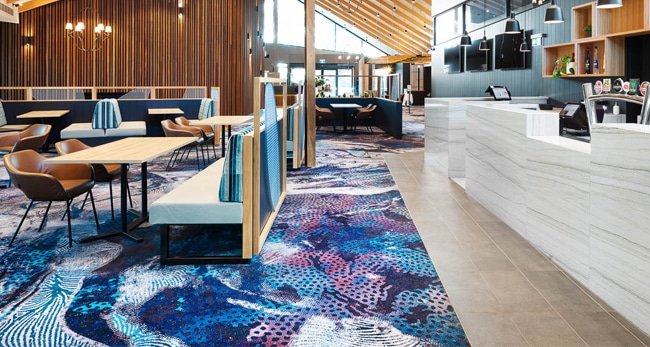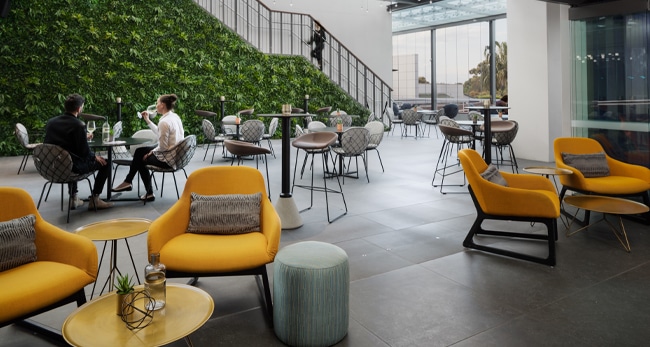Pia Sinha of Signature Floors recently spoke to Tina Fox, senior associate – interior design at Scott Carver about the future of hospitality design.
“Traditional hospitality offerings now have to work much harder to create a unique point of difference in this increasingly competitive market. What’s more, branding, artwork, authenticity, sustainability, staffing, smart partnerships, franchises are now essential,” Fox said.
The hospitality industry has been hugely impacted by pandemic-induced lockdowns and travel restrictions. While a significant part of our lives has moved to the online world, it simply fails to satisfy our physiological and psychological need for genuine human connection. At its heart, hospitality thrives on forging connectivity and creating shared experiences. Given our altered reality, venues such as restaurants, pubs, clubs and hotels will need to go beyond the necessities of food and rest and provide spaces for people to connect and network, albeit safely.

Project: Alleyway Bar, George St Sydney | Architect: Scott Carver | Photo courtesy of Scott Carver
Design flexibility and a sense of community
Flexibility and adaptability are a growing trend within hospitality spaces. With an increasing number of remote workers, hotels, for instance, have the opportunity to be flexible and provide day-time services such as private offices or co-working spaces within guest rooms with minimal adjustments.
“We see a real blurring between project typologies in the work that we do,” says Fox. “Commercial spaces want to feel like hospitality spaces. Or hotel and multi-residential projects are keen to incorporate working facilities and a hospitality influence.”
This indicates an opportunity for communal areas and food and beverage offers in many projects now – in the most unlikely of spaces. According to the designer, even traditionally underused spaces such as lobbies or conferencing areas are being transformed with better facilities to encourage community.
Using the right kind of materials
In a post-pandemic world, cleanliness and hygiene top the list of must-haves in hospitality design. That’s why choosing the right materials and surfaces is also an essential consideration. There is a growing demand for anti-microbial materials, non-porous finishes as well as touch-free fixtures.
In fact, resilient options such vinyl flooring are emerging popular, given their ability to allow for faster and more efficient cleaning. When disinfected properly, carpets make for hygienic choices, while also acting as a textural and colour differentiator between spaces.
The truth is guests want that soft feeling underfoot and for hospitality spaces to not appear clinical. Bespoke carpets for seated spaces in a restaurant, for instance, in combination with vinyl planks for passages, could be an excellent way to encourage safe movement. Even carpet tiles make for excellent flooring choices to create seamless visual cues that maintain social distancing while helping people move smoothly between spaces.
“Flooring is an essential layer to developing a unique design for clients. The right finish, colour and design can have a massive impact on the practicality and feel of a space. It can also help improve the space’s acoustics. Flooring is an important tool, to then help break up spaces, guide customer flow and give identity to specific areas,” Fox noted.
Speaking about the most popular types of flooring options, she added, “Every project is different, and we find that we use all types of flooring finishes depending on the brief and concept. We can go from designer carpets such as custom Axminster and luxurious stone on boutique projects to carpet tile, vinyl and floor tiles.”

Custom Axminster carpet by Signature Studio at Chirnside Park Country Club | Design: BSPN Architecture
Biophilic spaces
Since safety is a priority in hospitality design, designers may need to consider more open floor plans, open-air spaces and outdoor areas. Biophilic design elements such as environmental features, natural shapes, light and water work to bring the outdoors in, ultimately creating feelings of comfort and safety while alleviating stress and enhancing the mood.

Project: Rydges Hotel Campbelltown | Architect: Scott Carver | Photo courtesy of Scott Carver
Localised design
Another way to create a point of difference is by diversifying the local offer. “Clients are always keen to make sure that their spaces work really hard day and night. They want to make the best use of their facilities, encourage longer dwell times, create an atmosphere and a sense of community. As a result, it creates a very sophisticated market – those who are looking out for the next big idea to stand out from the crowd,” Fox said.
“Having an authentic local design expression seems to be very important these days. Long gone are the days of cookie-cutter international designs.”
With new international hotel brands on the rise in the Asia Pacific region, Fox finds that many existing hotels are now really looking at aggressive refurbishment plans to keep up to date. “We also see the expansion of small boutique brands and a focus on sustainability. Serviced apartment providers are looking to modernise with new upscale brands and a comprehensive refurbishments rollout.”
Given the current prolonged state of isolation, more and more people are seeking external outlets and a sense of destination; therefore, public social spaces and hospitality venues are poised to gain prominence. Through ideation, exploration and creative thinking – design offers hospitality brands the pathway to sustain growth and flourish.

